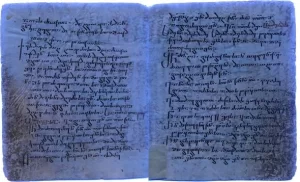Estimated reading time: 6 minutes
Table of contents
Recently, at the Shangdu site in Zhengzhou, more than 200 relics were discovered. Discoveries included several gold coverings and a large amount of gold.” The site where the archaeological find occurred was discovered in 2021 and is “a Shang Dynasty noble burial area in the south of East Street, east of Zijingshan Road, and north of Shuyuan Street in Zhengzhou City.” [i]
The main tomb revealed more than 200 “funerary objects.” This included 20 bronze pieces, 11 jade, five gold, 50 arrowheads, and over 120 shell coins and plaques with turquoise inlays and gold foiling. Six dog sacrifices were also found at the bottom of the main tomb. [vii]

Buried canines were discovered at the main tomb of the Shang Dynasty site. Photo by China News Service
The Shang Dynasty
The Shang Dynasty ruled the Yellow River Valley between 1600 B.C. and 1046 B.C. Animal and human sacrifice were common practices throughout the Shang Dynasty. Sacrificial remains were disposed of in burial pits or were laid to rest in the tombs of the dead.” [i]

Shangqiu temple honors legendary Shang Dynasty ancestor of business. Photo by Gary Todd/Wikimedia Commons
Dogs Buried Alive
One of the many discoveries at the site in China’s Henan Province included dogs that had been buried. Previous research has indicated that the Shang Dynasty sacrificed dogs, many of which were just puppies and had been buried alive. [iii]
Archaeologist Roderick Campbell stated that dog burials in China date back 9,000 years to the “Neolithic settlement of Jiahu.” He proposes that dog sacrifices may have “made a cheaper alternative” for the less well-off than humans. [ii]

A bronze age dog was buried with a bell around its neck at the Sipanmo site in Anyang, China. Photo by Roderick Campbell
Jade Dagger-Axe
A jade dagger axe was also discovered at the archaeological site. According to previous research, the dagger-axe is a non-utilitarian tool. This indicates that it was more for ornamental use. Ritual objects are carefully made using specific, “often hard-to-obtain raw materials.” [iii]

A relic, jade dagger axe was discovered at the Shang Dynasty site. Photo by China News Service
Furthermore, the tool first appeared in the “middle and late Neolithic,” making it the oldest jade weapon type. The dagger-axe is “the most common jade artifact, has the longest period of use, and has the most obvious ritual function.” See below for the evolution of the jade dagger-axe. [iv]

The evolution of the jade dagger-axe. Photo by Cheng Xue, Yingzhi Zu/Scientific Research
Bronze Wine Vessels
Among the relics were also bronze wine vessels. Some Chinese ritual bronze vessels, like the one discovered, were known as lei’s. A lei was “used to drink wine or to offer ritual libations.” [v]

A relic, a bronze wine vessel was unearthed at the Shang Dynasty site.Photo byChina News Service
A libation is a ritual during which liquid or grains are poured out “as an offering to a deity or spirit, or in memory of the dead.” Another Chinese bronze vessel is known as a gu. A gu was “tall and slender, with a slightly flared base,” as seen in the photo below. [vi]

A gu from the Shang Dynasty. Photo by Gary Lee Todd, Ph.D./Wikimedia Commons
Gold Mask
Finally, a gold mask was one other relic that was recently discovered. Based on its size, the gold mask is said to belong to an adult. Experts intend to expand their research on golden masks and how they relate to “the dynasty’s burial rituals and gold culture.” [viii]

A gold mask was discovered at the Shang Dynasty site.Photo byChina News Service
References
[i] Stephanie Pappas, Dogs Sacrificed by Shang Dynasty Were Just Pups. Some Were Even Buried Alive. (May 7, 2019)
[ii] Id.
[iii] Xue, C. and Xu, Y. (2017) On the Origin of Early Jade Dagger-Axe: A Brief Analysis. Archaeological Discovery, 5, 178-186. DOI: 10.4236/ad.2017.53011.
[iv] Id.
[v] Wikipedia, Gu (vessel), (2022)
[vi] Id.
[vii] Teller Report, Gold cladding found at the Shangdu site in Zhengzhou, (Sep. 16, 2022)
[viii] Ewing, Archaeologists in China Find Ancient Golden Funeral Mask, (Sep. 16, 2022)
If you have any questions or want to report a tip or other concern, please do not hesitate to message DOPE Quick Reads.
[Article Note: This piece was originally published on NewsBreak and has been archived and transferred to DOPE Quick Reads to preserve its informational value. Original publication date: 2022-12-25]
Read more stories that interest you
Churches now see the number of alarming acts of hostility go up-A new study says CA faces most cases
Rise in Hostility Against Churches in California: A Concerning Trend A recent study by the Family Research Council (FRC) reveals an alarming increase in acts of hostility against churches in California. The study, “Hostility Against Churches Is on the Rise in the United States”, analyzed incidents from January to November 2023. It identified 436 incidents […]
A gold ring & 21 coins buried by a soldier during the 15th century inspired the GOT series-Recently found by a trio
The Wars of the Roses played a significant role in shaping the history of England. Updated: October 2025 The Remarkable Discovery in North Yorkshire Believed to have been buried by a soldier during the War of the Roses, a gold ring and 21 coins were discovered in Harrogate in North Yorkshire. A father and his […]
For the first time, no DeLorean needed: Easily journey back to the 1960s and see how Latinos enjoyed Chicago nightlife
Get ready for a thrilling journey to the vibrant nightlife of 1960s Chicago, where you can enjoy the captivating energy of Latin music and storytelling under the open sky at Orange County’s Mission San Juan Capistrano Central Courtyard—this summer. Don’t miss Orange County’s first unforgettable production of “La Havana Madrid,” written by Sandra Delgado, a 2021 United […]
Californians who buy frozen nuggets- Tyson announces new 29,819 lb recall due to a minor oral injury
Tyson Foods, a leading global food company, has issued a voluntary recall for approximately 30,000 pounds of its product, “Fun Nuggets.” This is because they may contain metal fragments. California distributors are among nine states who received shipments now being recalled. This follows the Tyson Recall involving significant batches of contaminated products. If you have bought this product, […]
Many Neolithic natives made their gruel and stew using cooked cereal
Analysis of ancient pottery reveals new discovery Recently, a team of scientists headed by the University of Bristol discovered that “cereals, including wheat, were cooked in pots.” The scientists used chemical analysis of pottery that had been well-preserved and discovered “in the waters surrounding small artificial islands” in Scotland. [i] The cereal was cooked in […]










